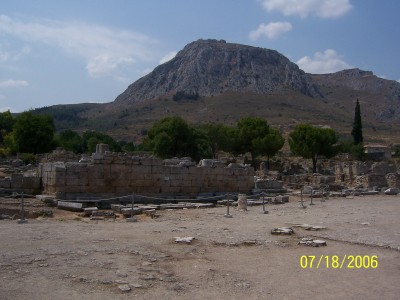|
Bema
 The
Acrocorinth (lit. high Corinth) is in the background; the Bema
is in the front. The Bema would be where the judge of a town
would sit or an orator the town would speak or make an
announcement to the public. The
Acrocorinth (lit. high Corinth) is in the background; the Bema
is in the front. The Bema would be where the judge of a town
would sit or an orator the town would speak or make an
announcement to the public.
How is the Bema significant for
understanding the world of Paul?
First, the Bible, in the book of Acts, records that Paul was
brought to the Bema under accusations of contrary teaching. The
judge dismisses the affair as a Jewish quarrel.
But when Gallio was proconsul of Achaia, the Jews made a
united attack on Paul and brought him before the bema
(tribunal). They said, "This man is persuading people to
worship God in ways that are contrary to the law." Just as Paul
was about to speak, Gallio said to the Jews, "If it were a
matter of crime or serious villainy, I would be justified in
accepting the complaint of you Jews; but since it is a matter of
questions about words and names and your own law, see to it
yourselves; I do not wish to be a judge of these matters." And
he dismissed them from the tribunal. Then all of them seized
Sosthenes, the official of the synagogue, and beat him in front
of the tribunal. But Gallio paid no attention to any of these
things. (Acts, chapter 18:12-17)
The Roman officials often viewed Christianity as a sect within
Judaism. To continue with Paul through Corinth, go to
Cenchreae.
The Bema, however, also
plays a role in Paul's first letter to the Corinthians.
The Bema was where orators would speak. In Paul's day,
people went to school to learn rhetoric, the art of convincing speech.
The Bema in Athens, like in Corinth, is located in the heart of
the city. Public speaking was important and those who
could do it well had respect and power. Many even demanded that Paul
himself obey these conventions.
 How is Paul
confronting his culture?
How is Paul
confronting his culture?
Paul refuses to give into
the demands that he use rhetoric. As scholar Anthony
Thiselton points out -- rhetoricians were comfortable using
“personality, cajoling, and similar techniques.” Paul does not
want people to think their faith rests on his speaking ability,
his personality or his tricks, but on the power of God.
When I came to you, brothers and sisters, I did not come
proclaiming the mystery of God to you in lofty words or wisdom.
For I decided to know nothing among you except Jesus Christ, and
him crucified. And I came to you in weakness and in fear and in
much trembling. My speech and my proclamation were not with
plausible words of wisdom, but with a demonstration of the
Spirit and of power, so that your faith might rest not on human
wisdom but on the power of God. (1 Corinthians 2:1-5)
source:
Thiselton, Anthony. Corinthians,
NIGTC. Grand Rapids, Eerdmans, 2000, p. 218.
|



 The
Acrocorinth (lit. high Corinth) is in the background; the Bema
is in the front. The Bema would be where the judge of a town
would sit or an orator the town would speak or make an
announcement to the public.
The
Acrocorinth (lit. high Corinth) is in the background; the Bema
is in the front. The Bema would be where the judge of a town
would sit or an orator the town would speak or make an
announcement to the public.